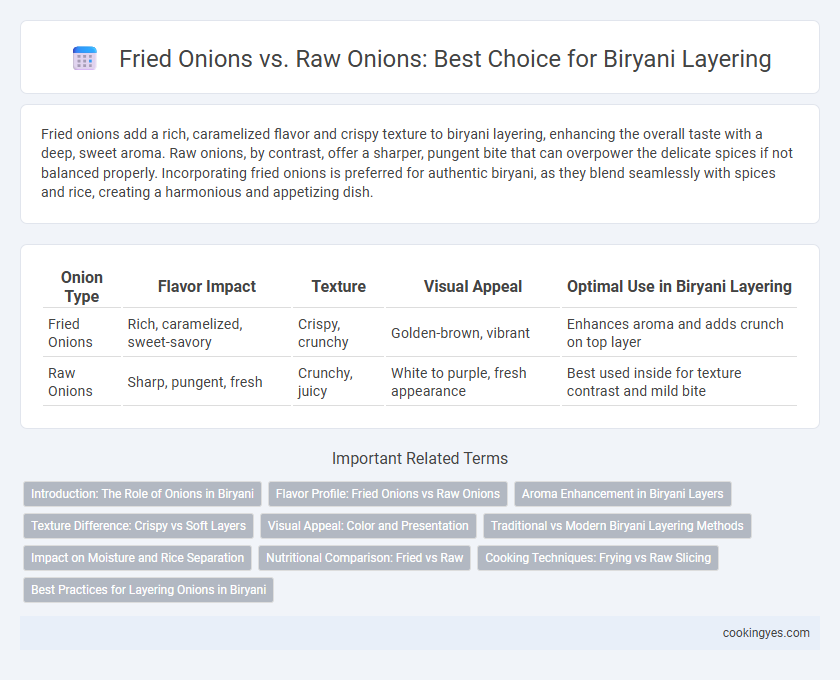Fried onions add a rich, caramelized flavor and crispy texture to biryani layering, enhancing the overall taste with a deep, sweet aroma. Raw onions, by contrast, offer a sharper, pungent bite that can overpower the delicate spices if not balanced properly. Incorporating fried onions is preferred for authentic biryani, as they blend seamlessly with spices and rice, creating a harmonious and appetizing dish.
Table of Comparison
| Onion Type | Flavor Impact | Texture | Visual Appeal | Optimal Use in Biryani Layering |
|---|---|---|---|---|
| Fried Onions | Rich, caramelized, sweet-savory | Crispy, crunchy | Golden-brown, vibrant | Enhances aroma and adds crunch on top layer |
| Raw Onions | Sharp, pungent, fresh | Crunchy, juicy | White to purple, fresh appearance | Best used inside for texture contrast and mild bite |
Introduction: The Role of Onions in Biryani
Fried onions contribute a rich, caramelized flavor and golden-brown color, enhancing the biryani's aroma and visual appeal, while raw onions offer a contrasting crunch and sharpness when layered. The choice between fried and raw onions significantly influences the texture and depth of taste, making each approach integral to regional biryani variations. Understanding their distinct roles helps achieve the perfect balance of sweetness and pungency essential for authentic biryani.
Flavor Profile: Fried Onions vs Raw Onions
Fried onions impart a rich, caramelized sweetness and deep umami flavor that enhances the complexity of biryani, creating a savory and aromatic experience. Raw onions, by contrast, provide a sharp, pungent bite and a crisp texture that can add freshness but may overpower delicate spices. Using fried onions in biryani layering balances the dish's flavor profile by adding depth and mellowing harshness, while raw onions contribute a bright contrast but risk disrupting the harmony of spices.
Aroma Enhancement in Biryani Layers
Fried onions significantly enhance the aroma of biryani by releasing rich, caramelized flavors that infuse each layer, creating a deep, savory fragrance. Raw onions, in contrast, offer a sharper, less complex scent that can diminish the overall aromatic profile of the dish. Incorporating fried onions into biryani layering elevates the sensory experience, making the aroma more inviting and memorable.
Texture Difference: Crispy vs Soft Layers
Fried onions provide a crispy texture that adds a delightful crunch and enhances the overall mouthfeel of biryani layers. Raw onions contribute softer, moist layers that blend seamlessly with the spices and rice, creating a tender bite. Choosing between fried and raw onions directly affects the textural contrast and mouthfeel, making fried onions ideal for a crispy finish and raw onions better for softness.
Visual Appeal: Color and Presentation
Fried onions contribute a rich golden-brown hue that enhances the visual appeal and texture of biryani, creating an inviting contrast with the white rice. Raw onions, while adding a fresh crunch, lack the caramelized color and crispiness that elevate the dish's presentation. The deep, toasted layers of fried onions provide a more vibrant and appetizing look, making them essential for authentic biryani aesthetics.
Traditional vs Modern Biryani Layering Methods
Traditional biryani layering methods emphasize the use of fried onions to impart a rich, caramelized flavor and enhance aroma, while modern biryani recipes often incorporate raw onions for a fresher, sharper taste and a crunchier texture. Fried onions contribute to the depth and sweetness essential in classic Mughlai or Hyderabadi biryanis, whereas raw onions are favored in contemporary or fusion variants for their more pronounced bite and moisture retention. The choice between fried and raw onions reflects regional preferences and the evolving culinary practices in biryani preparation.
Impact on Moisture and Rice Separation
Fried onions add a crispy texture and absorb excess moisture, helping to keep biryani rice layers separate and fluffy. Raw onions release more water during cooking, which can increase moisture and cause rice grains to clump together. Using fried onions enhances the layering by maintaining dryness and distinct rice grains, essential for authentic biryani texture.
Nutritional Comparison: Fried vs Raw
Fried onions used in biryani layering contain higher calorie content and increased fat due to the oil absorption during frying, while raw onions offer more vitamins and antioxidants like vitamin C and quercetin. Frying reduces the water-soluble nutrients in onions but enhances their flavor through caramelization, impacting the overall savory profile. Nutritionally, raw onions provide better antioxidant benefits, whereas fried onions contribute to richer taste with added fats.
Cooking Techniques: Frying vs Raw Slicing
Fried onions add a deep, caramelized flavor and crispy texture that enhances the richness of biryani layers, while raw onions provide a fresh, sharp bite and moisture. Frying onions in oil until golden brown creates a sweeter, nuttier profile that infuses into the rice, contrasting with raw onions' clean, pungent taste. Choosing between frying and raw slicing impacts the biryani's overall balance of flavors and texture, with fried onions offering a more complex and roasted character.
Best Practices for Layering Onions in Biryani
Fried onions provide a rich, caramelized flavor and crispy texture essential for authentic biryani layering, enhancing both aroma and taste. Raw onions, when used in biryani layering, release moisture that can lead to sogginess, compromising the dish's texture and layering integrity. Best practices recommend frying thinly sliced onions until golden brown before layering, ensuring a balanced flavor profile and maintaining the biryani's fluffy, separate rice grains.
Fried Onions vs Raw Onions for Biryani layering Infographic

 cookingyes.com
cookingyes.com